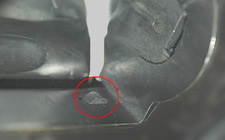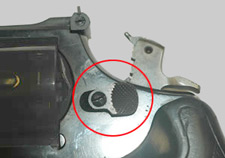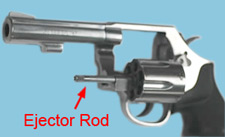- 01: Introduction
- 02: History
- 03: Propellants, Firearms, and Ammunition Development
- 04: Modern Firearms Manufacture
- 05: Small Arms Ammunition
- 06: Evidence Handling Procedures
- 07: Equipment and Instrumentation
- 08: Examination of Firearms
- 09: Cartridge and Shotshell Examination
- 10: Characterization and Evaluation of Fired Projectiles
- 11: Bullet Comparison and Identification
- 12: Gunshot Residue and Distance Determination
- 13: Toolmark Identification
- 14: Communicating Results
- Resources


Double-Action Revolvers
Home > Examination of Firearms > Handguns > Double-Action Revolvers

Double-action revolver uncocked

Cylinder stop
Double-action revolvers are similar to single-action revolvers, with the following exceptions:
- Function.
- Double-action revolvers allow the hammer to be cocked and released with a single pull of the trigger.
- Most double-action revolvers have the capability to function in either the double- or single-action mode. However, some models are designed to fire in the double-action mode only; the hammer cannot be manually cocked and the trigger must be pulled.
- Used in the double-action mode, the cylinder is locked into place by the cylinder stop; the hammer does not lock into place since the cocking and releasing of the hammer is achieved in one motion.
- Ejection/extraction.
- In double-action revolvers, the cylinder release device is generally located on the left rear of the frame, whereas in single-action revolvers, the loading gate is located on the right.
- By manipulating the release device, the cylinder will unlock and swing out to the left of the firearm. The front of the cylinder has an ejection rod, which is used to eject all the fired cartridge cases or cartridges from the cylinder with one movement.

Cylinder release device

Double-action cylinder ejector rod
Modern double-action revolvers generally use the same accidental discharge prevention mechanisms as single-action revolvers – the transfer bar or the hammer block.




